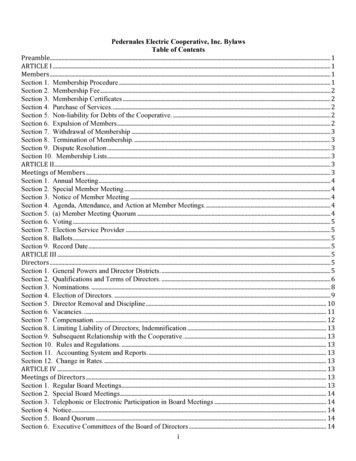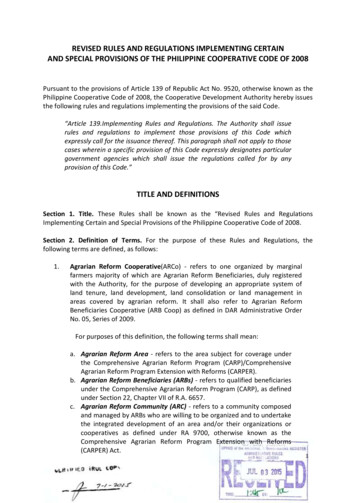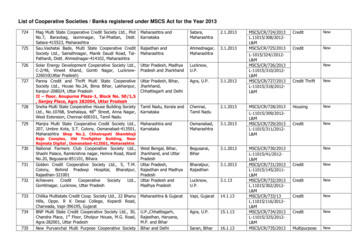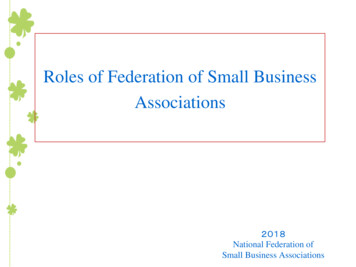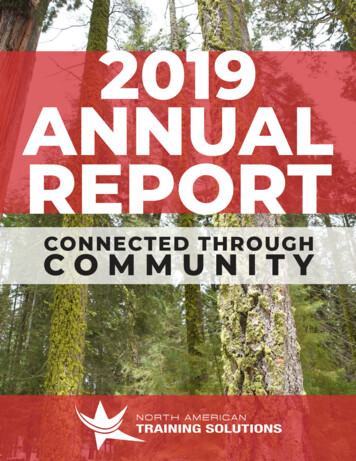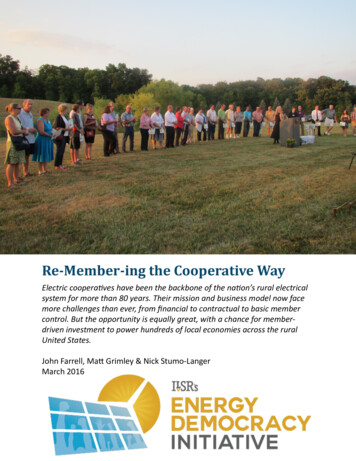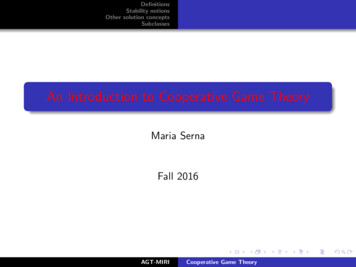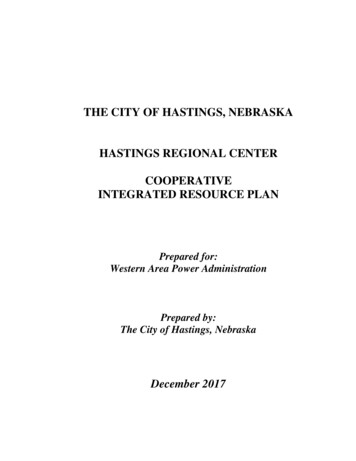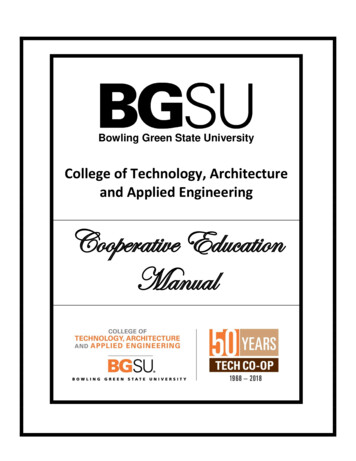
Transcription
Bowling Green State UniversityCollege of Technology, Architectureand Applied EngineeringCooperative EducationManual
BGSU College of Technology, Architecture and Applied Engineering Cooperative Education Manual, 2017FOREWORDThis College of Technology, Architecture and Applied Engineering Cooperative Education Manual containsall general information, policies and procedures needed to understand and become successfully involvedin all cooperative education courses (TECH 2890, 3890 and 4890).Established in 1968, the Cooperative Education Program provides students the opportunity to integrateacademic coursework with actual work experience at companies in the United States and throughout theworld in their chosen field of study. These experiences strengthen and enhance student's overallcompetencies, increasing the possibility of attaining, and often placing them directly into, a successful andfulfilling position upon graduation.While all information, rules and regulations provided within this manual are the standard, we alsounderstand that each student’s personal situations differ. The Cooperative Education Program is open todialogue with students, their families and representatives to establish and maintain the best possibleoutcome for that student, negotiated on a case-by-case basis, should this course of action be warranted.CREDITSTwenty First Edition, 2019Edited by Melissa Partin-Harding, M.Ed.Assistant Director, Office of Cooperative EducationBGSU College of Technology, Architecture and Applied Engineering (CTAAE)Prior Editions Written and Edited by Mr. Barry Piersol and Mr. Thomas Siebenaler, M.Ed.First Edition written by Mr. Thomas Jensen, Ph.D.CONTACTCooperative Education ProgramBowling Green State UniversityCollege of Technology, Architecture and Applied Engineering102 Technology BuildingBowling Green, OH 43403Phone: (419) 372-7581Fax: (419) 372-2800Email: coop@bgsu.eduWeb: www.bgsu.edu/techcoopNote: All policies, procedures, and information within this document are subject to change.Page 1 of 39
BGSU College of Technology, Architecture and Applied Engineering Cooperative Education Manual, 2017TABLE of CONTENTSConcept, Mission & Goals, Learning Outcomes .3Accreditation & Professional Affiliations .4Definition of Cooperative Education .5Benefits (Student, Employer & College) .6CO-OP Course Requirements .8Ethical Standards .8Employer Responsibilities .9Student Responsibilities . 10Course Completion: Methods & Planning . 12Prerequisites . 13Application & Approval, College Representative . 14Site Review . 15Report . 16Wage & Compensation . 17Evaluations . 18CO-OP Search Services & Resources. 19Sample Job Interview Questions. 21Exceptions . 22Q&A . 30Testimonials . 37Page 2 of 39
BGSU College of Technology, Architecture and Applied Engineering Cooperative Education Manual, 2017CONCEPT, MISSION & GOALS, LEARNING OUTCOMESThe Cooperative Education Program in the College of Technology, Architecture and Applied Engineering atBowling Green State University is a mandatory program and a graduation requirement that integratesclassroom academics with practical work experience. Students alternate semesters of traditional campuscoursework with semester-long periods of full-time employment in industry, business, organizations orgovernment.MISSIONThe Cooperative Education Program facilitates student’s cooperative education experiences with thepurpose of augmenting academic learning through experiential education .GOALS To assure the students approved co-op is directly related to the student’s field of study. To assure each student receives supervision from an experienced mentor from their industry whilecompleting their co-op. To assure each student receives compensation during their co-op. To assure each student receives feedback from their co-op employer and assigned faculty representativethrough an evaluation and site review. To assure each student completes a written report to assess their co-op experience. To assure that students are encouraged to complete their co-ops in multiple, alternating and rotatingcooperative education experiences. To assure that each student receives industry-related, experience in the field of their major prior tograduation.LEARNING OUTCOMES Students will assess the relationships between theory and practice as observed in a professionalsetting.Students will develop interpersonal and communication skills through networking and collaboratingwith diverse personnel.Students will demonstrate the ability to effectively interact in varied industry environments.Students will demonstrate professional ethics as it relates to industry.Students will assess industry standards related to quality and productivity.Student will assess how the co-op experience relates to education and career success.Students will apply critical thinking skills as it relates to their profession.PROGRAM ACCREDITATIONThe College of Technology, Architecture and Applied Engineering CO-OP Program at Bowling Green StateUniversity has been granted full accreditation from The Accreditation Council for Cooperative Education(ACCI).Page 3 of 39
BGSU College of Technology, Architecture and Applied Engineering Cooperative Education Manual, 2017“Mission: The Accreditation Council for Co-op and Internship (ACCI) is an association dedicated toencouraging and recognizing excellence in programs of cooperative education and academic internships.Purpose: The purpose of this organization is to serve the public through the establishment andmaintenance of criteria and procedures for accrediting academic internship and cooperative educationprograms.Objectives: The specific objectives are to establish and maintain an accreditation process, to effectivelyreview programs seeking accreditation, to provide mentoring and training to raise standards, to promotethe significance of student participation, and recognize and promote excellence in cooperative educationand academic internship programs.”Accreditation Council for Co-op and Internship. (n.d.). Mission and Objectives. Retrieved lPROFESSIONAL AFFILIATIONSCooperative Education & Internship Association, Inc.The College of Technology, Architecture and Applied Engineering CO-OP Program at Bowling Green StateUniversity is a proud member of the Cooperative Education & Internship Association, Inc. (CEIA).“CEIA was founded in September 1963. The original mission: To provide professional development andresources to the field of cooperative education.CEIA is a not-for-profit 501C (3) organization, incorporated in the State of Indiana. At the first annualbusiness meeting in 1963, the constitution and bylaws were adopted. The first annual conference was heldin September, 1963 at the Ford Motor Company in Detroit, Michigan. Dr. Donald Hunt of the University ofDetroit was elected the association's first president.CEIA remains the leader in providing professional development and resources to practitioners in the fieldsof cooperative education and internship program management. The original mission of the organization asenvisioned by its founders in 1963 is carried out through an expanding number of training activities, anannual national conference, and support and encouragement for on-going research and publications.”Cooperative Education & Internship Association. (n.d.). About. Retrieved fromhttp://www.ceiainc.org/about/The National Commission for Cooperative EducationThe College of Technology, Architecture and Applied Engineering CO-OP Program at Bowling Green StateUniversity is a proud affiliate of World Association for Cooperative Education (WACE) formerly TheNational Commission for Cooperative Education (NCCE).“Effective July 1, 2010, The National Commission (NCCE) has joined with The World Association forCooperative Education (WACE) to “globally advance high quality cooperative & work-integratededucation.”Page 4 of 39
BGSU College of Technology, Architecture and Applied Engineering Cooperative Education Manual, 2017Vision: The organizations vision is to be the premier international organization linking the world’s leadinghigher education institutions, employers and public authorities, all of whom share a profound commitmentto preparing new generations for a lifetime of professional success in today’s global and diverse workforce.Our vision will be achieved through research, programs & services designed to globally advance all forms oflearning where education is integrated with professional work experience.”WACE advancing cooperative & work-integrated education. (n.d.). Mission and Vision. Retrieved fromhttp://www.waceinc.org/mission.htmlDEFINITION of COOPERATIVE EDUCATION (CO-OP)There are many kinds of cooperative education programs throughout the nation which operate at severallevels. It is called "cooperative" because such programs usually require the close cooperation andcoordination of the student, the University and the employer, resulting in multiple experiences, ratherthan one-time occurrences. Cooperative education has come to mean an alternation of on-campuscoursework and work experiences on multiple occasions. Cooperative education courses are notinternships. By definition, cooperative education courses and programs grant university course credit forwork experiences. Using industry standards and university practices across the United States and theworld, a work experience cannot be designated a “CO-OP” if it does not grant university course credit.Definition below provided by the World Association for Cooperative Education (WACE):“College cooperative education is formally recognized as an academic program integrating classroomlearning and productive work experiences in a field related to a student's academic and career goals. Co-opprovides students with progressive learning experiences integrating theory and practice. As an academicprogram, co-op serves as a partnership among students, educational institutions and employers.”This operational definition includes a number of responsibilities and agreements among the educationalinstitution, employer, and the co-op student. Those agreements focus on academic credit, learningassessments, on-going advising and work supervision. For a full description of these responsibilities, pleasevisit: www.WACEINC.orgWACE advancing cooperative & work-integrated education. (n.d.). eGuides. Retrieved EGuide2015-16.html#p 8PROGRAM BENEFITSThe CO-OP program, when properly utilized, has important benefits for the student, employer and Collegeof Technology, Architecture and Applied Engineering. Each participant can derive special and significantbenefits.Benefits to the StudentEach semester, approximately, 70-90% of CTAAE students are hired into a full-time position, aftergraduation from BGSU, in their chosen career as a result of their CO-OP positions and/or networking. TheCO-OP program allows students to integrate classroom theory with practical, on-the-job experience. ItPage 5 of 39
BGSU College of Technology, Architecture and Applied Engineering Cooperative Education Manual, 2017enables the student to apply theory and skills learned in the formal classroom to the demands of a real jobsituation. The reverse sequence is also true, providing a base of job-acquired experience to supportsubsequently learned classroom theory, increasing knowledge retention and student GPAs.CO-OP employment enables students to earn wages while learning. This helps students supportthemselves and places them in situations where they have real responsibility. In this context, the studentis forced to develop sound, professional work habits. Another benefit of the cooperative educationprogram is to provide those students who have 3 CO-OP courses required for their degree with theequivalent of one year's industrial work experience upon graduation.The CO-OP program can facilitate the student's career development as can no other experience. Workenvironments can be chosen to test academic and career goals. The first CO-OP is usually taken during thefreshman year when there is still much uncertainty in the student's mind regarding the selection of theirfield of study and career goals. The CO-OP experience provides an understanding of a target work environment and its diversity of work roles. This process of career clarification and commitment can bedeveloped more in CO-OPs taken than at later times in the student's career path. With each workexperience, students are able to recognize the need for additional course work that would better preparethem for permanent employment after graduation.In addition, the CO-OP work experiences and search process provides opportunities to network within theindustry, leading to potential post-graduation employment. While students search for CO-OPs, they aregradually building a very useful list of contacts and future job references. When careful and continuousfollow-up is applied, the contacts made in this process can lead the student to a future CO-OP or jobopportunity.Benefits to the EmployerThousands of companies and agencies have participated in the cooperative education program since 1968.The College of Technology, Architecture and Applied Engineering needs and appreciates these participating employers, for without them, the college could not produce as well prepared graduates as it currentlydoes.CO-OP students can help employers meet specific and/or short term needs. CO-OP students can be usedto free, or assist, regular employees for projects and tasks which they seem unable to start or completeunder the pursuit of their regular duties.Many employers view the CO-OP program as their most cost-effective recruiting tool. They can identifystrong candidates for permanent job positions and mentor students throughout the duration of the workexperience so they are well-suited to their specific needs. Since many CO-OP students and employers alsosee the benefits of working for different employers, thus gaining a more diversified background, employers should be willing to help develop CO-OP students at all levels whether or not they are earmarked foreventual permanent employment with their particular company.Employer interaction with CO-OP students and the faculty representative, who conduct the co-op sitereivew, helps employers become exposed to new ideas, research and developments in higher education.Employers can also use this opportunity to express any needs and issues they might have with the CollegePage 6 of 39
BGSU College of Technology, Architecture and Applied Engineering Cooperative Education Manual, 2017or BGSU as a whole. In so doing, they may learn of University resources which can be made available tothem (e.g., seminars, workshops, consultants and specially designed on-site training programs).There are many employers who, apart from the benefits mentioned, take pleasure from the fact that theyare making a positive contribution to the educational process and the career development of Universitystudents. This is also a wonderful opportunity for employers to give back to BGSU and their community,as many previous BGSU alumni and employers have chosen to do.Benefits to the College of Technology, Architecture and Applied EngineeringThe CO-OP program keeps College of Technology, Architecture and Applied Engineering programs,curriculum and faculty up-to-date and relevant with current trends and technologies in industry, fromlocations around the United States and the world. The College of Technology, Architecture and AppliedEngineering University’s representative (administrative staff or faculty member) who conduct a co-op sitereview for each student completing a CO-OP course, each semester, observes changes and trends intechnology, organization, management, job content and demand for jobs.In addition, the University representative evaluates the student’s required CO-OP report, which asks thestudents to respond to questions within the report that have curriculum enhancement implications.With the University representative experiencing contact in the field, this motivates faculty to becomeattracted to several other industrial resources. Networking (guest speakers, possible advisory committeemembers, etc.), physical resources (materials, samples, equipment, etc.) and additional CO-OP stations arethe most common (among many others) resources sought and found.The College of Technology, Architecture and Applied Engineering is anxious to continuously establishindustrial connections and contacts. The CO-OP site review helps identify the training needs of industrialpersonnel, communicate the availability of scheduled technical workshops, seminars and degreeprograms, and possibly establishing a process that would identify a customized solution to a corporatetraining or education problem.CO-OP COURSE REQUIREMENTS* (TECH 2890, TECH 3890 & TECH 4890) Job duties must be related to student’s academic program field of study.CO-OP employment cannot be self-employed or performing job duties from student’s personalresidence. Student must work at a professional location where business is conducted, at all times.Student must work (40 hours per week) for 1 semester to attain 1 co-op course credit(or PART-TIME format: 20 hours/week for 2 consecutive semesters for 1 co-op course credit).The student receives compensation for their employment as set forth by the United StatesDepartment of Labor.* These courses can be taken by any BGSU student, from any College or program.FAILURE TO COMPLETE CO-OP COURSE REQUIREMENTSMethods (ways) which students can lose their CO-OP course credit (fail the course): Student is terminated (fired) by their employer from their CO-OP position. Student quits their job (employment) premature of the CO-OP course’s completion date. Student fails to complete required course requirements, tasks, and/or assignments.Page 7 of 39
BGSU College of Technology, Architecture and Applied Engineering Cooperative Education Manual, 2017ETHICAL STANDARDSWe ensure that no preferential treatment is given to one student over another regarding CO-OP positionsor program policies and opportunities in students’ pursuit of successfully achieving our program missionand goals. We do this by offering our students equally distributed and advertised resources such as: CO-OP position recruitment and application system through which all students have a personalaccount provided them, with equal opportunity to apply for CO-OP positions posted within thesystem. Positions are available continuously, every spring, summer and fall semester. Advising opportunities are offered by appointment, walk-in, email and via phone/internet to allstudents, providing resources and assistance specific to their personal needs at any time.CO-OP courses and program functions are published in the BGSU Student Handbook, stated conduct.htmlStudent RightsOne of the concerns of Bowling Green State University is to provide each student with the opportunity tolearn. Some personal freedoms and rights of students include, but are not limited to:1. Freedom of inquiry, speech and assembly.2. Freedom from threats.3. Freedom from acts of violence.4. Freedom from unfair or obscene treatment from others.5. Freedom from interference from others in an unreasonable and unauthorized manner while inclass, activities and public events.6. Freedom from theft and willful destruction of personal property.7. Right to study and to learn in an atmosphere of academic freedom.8. Right to procedural due process in University conduct action.9. Right to be governed by justifiable academic regulations.10. Right to be informed of the regulations for academic and social conduct, and graduationrequirements of the University.11. Right to petition for redress of grievances, academic and nonacademic.12. Right to be informed in writing of alleged violations of the Code of Student Conduct.Student Handbook, Codes of Conduct. (n.d.). eGuides. Retrieved from t.htmlEMPLOYER RESPONSIBILITIESEmployers are required to meet the following requirements when employing students: The CO-OP student is assigned job duties related to their major. The employer offers the student full-time work (40 hours a week) lasting one semester. Please seethe CO-OP Calendar for specific dates. The part-time option employs a student 20 hours/week for 2 consecutive semesters(equaling 1 CO-OP course credit). The student should be supervised by an employee who can act as a mentor for the student,someone that student can learn from.Page 8 of 39
BGSU College of Technology, Architecture and Applied Engineering Cooperative Education Manual, 2017 Employer provides a professional business location where the student is to complete their work.No CO-OP credit work duties can be performed from the student’s personal residence.The student receives compensation for their employment as set forth by the United States FairLabor Standards Act. fThe employer completes a Mid-term and Final evaluation on the student's performance. Details onthis are included in Employer Evaluations section.The employer meets with a BGSU representative sometime during the student's CO-OP semester.Essentially, there should be no major difference between a CO-OP employee and a full-time/entrylevel employee; this is the essence of CO-OP.The employer should practice ethical standards that follow the Occupational Safety and Health Actof 1970 (OSH Act) as directed by the United States Department of Labor.All employers are expected to comply with laws enforced by the United States Equal EmploymentOpportunity Commission (EEOC).STUDENT Read and sign the Cooperative Education Policy and Procedure Statement form. (via Orientation)Complete the College of Technology, Architecture and Applied Engineering CO-OP Orientation,via their Canvas online account.Complete 1 - 3 (depending on the major) semester-long, full-time (40 hours/week),CO-OP courses, following all regulations associated with CO-OP course completion.If a full-time position cannot be secured, the part-time method can be used.To receive CO-OP course credit, the student must register their CO-OP course with the College ofTechnology, Architecture and Applied Engineering CO-OP Office via the Co-op Registration linklocated at www.bgsu.edu/techcoop prior to beginning their employment.Each CO-OP course is worth 4 university credit hours.CO-OP employment cannot be self-employed or performing job duties from your personalresidence. You must work at a professional location where business is conducted.Students must make financial arrangements to pay the 4 credit hour CO-OP course tuition priorto their submitting an application for CO-OP course registration.Retroactive work experience will not be considered for CO-OP course credit, except throughapproved methods and consultation with the CO-OP Program. (See Credit by Exam Option)Semesters spent completing a CO-OP should alternate with semesters spent on campus.The student’s final semester should be spent completing on-campus courses,not completing a CO-OP course.The student’s CO-OP position job duties must be directly related to their major.Students receive four (4) student credit hours for each CO-OP course successfully completed. The totalnumber of CO-OP’s required for graduation differs depending on each student’s major and is noted ontheir individual program check-sheet. It is the student’s responsibility to know their requirements and touse available resources and take appropriate action to complete these requirements.If a student completes more than their required CO-OP courses, the CO-OP credit hours accumulatedcould reduce the number of hours within their major concentration or electives. These substitutions mustbe approved by the student's academic advisor, prior to the onset of additional CO-OP courses.Page 9 of 39
BGSU College of Technology, Architecture and Applied Engineering Cooperative Education Manual, 2017COMPREHENSIVE LIST OF STEPS TO COMPLETE REQUIRED CO-OP COURSES:1. Enter College of Technology, Architecture and Applied Engineering, consult with your academic advisorto develop a graduation plan (see example co-op coursework alternation patters in the Co-op Manual.2. Enroll in courses.3. Complete CO-OP Orientation, prerequisite prior to completing first CO-OP.4. Prepare/update resume, prerequisite for TECH 2890, and subsequent CO-OP.5. Continue coursework.6. Begin your CO-OP search.7. Interview with company for CO-OP position.8. Accept CO-OP position offer.9. Submit CO-OP registration form via www.bgsu.edu/techcoop Semester Co-op Registration link.10. Approved/denied by Chair, CO-OP Office, upon approval, enrolled in appropriate (TECH 2890, 3890 or4890) CO-OP.11. International students should also consult with the International Programs and Partnership Office formore information regarding the appropriate work authorization requirements.12. Complete CO-OP requirements: perform work duties, submit CO-OP Report, participate in Site Review.13. Matriculate into the College of Technology, Architecture and Applied Engineering after completingmatriculation requirements for the student’s major including TECH2890.14. Continue coursework and CO-OPs, complete last CO-OP prior to last semester of courses.15. Complete final semester of on-campus coursework.16. Graduate from BGSU!STUDENT CHECKLIST TO COMPLETE CO-OP COURSE (TECH 2890, 3890, 4890) Prerequisites completed: CO-OP Orientation, hired by company and company understands you areusing employment for BGSU course credit. Submit a Cooperative Education application/registration prior to starting the work experience you wishto use for CO-OP credit. (Use instructions presented in this manual.) Be sure that the CO-OP registration process is complete and approved prior to beginning your workexperience. Check your Academic Schedule via your MyBGSU account to be sure the CO-OP course (TECH 2890,3890 or 4890) is listed on your schedule. If the CO-OP course is not listed, you are not registered andwill not receive credit for your CO-OP course. If this is the case, you must take appropriate action toresolve this before beginning work that semester. Secure housing, transportation and necessary living arrangements at your CO-OP work location prior todeparture for CO-OP site. Notify the Office of Cooperative Education of your correct address while on CO-OP.Page 10 of 39
BGSU College of Technology, Architecture and Applied Engineering Cooperative Education Manual, 2017 Communicate frequently with your assigned College of Technology, Architecture and AppliedEngineering assigned Faculty Representative, who will complete the site review, grade your CO-OPassignments and act as a mentor for you to learn from. Be sure to check your BGSU e-mail regularlywhile working at your CO-OP site as it is the formal means for BGSU communication and you may haveyour cell phone blocked during working hours. Ensure that your employer completes both the Mid-term and Final Student Performance Evaluations. Complete and submit the required CO-OP Assignment
BGSU College of Technology, Architecture and Applied Engineering Cooperative Education Manual, 2017 Page 4 of 39 "Mission: The Accreditation Council for Co-op and Internship (ACCI) is an association dedicated to encouraging and recognizing excellence in programs of cooperative education and academic internships. Purpose: The purpose of this organization is to serve the public through the .


